MGMT90012: Role of Bias in Recruitment and Selection Processes
VerifiedAdded on 2022/12/23
|12
|3583
|4
Essay
AI Summary
This essay delves into the significant role of bias in recruitment and selection processes, examining various types of biases such as halo effect, horn effect, leniency effect, contrast effect, conformity bias, confirmation bias, and personal similarity bias. It explores the impact of these biases on hiring decisions, organizational productivity, and diversity. The essay also discusses the role of merit, while acknowledging its limitations, and investigates the frequency of bias in recruitment. Furthermore, it outlines interventions and tools used to reduce bias, such as Blendoor, GapJumpers, Interviewing.io, Texito, Project Include, Workplace, Unitive, and Unbias.io, and analyzes their effectiveness. Finally, the essay concludes with strategies to overcome bias, aiming to increase fairness in the recruitment of new hires within organizations, emphasizing the importance of standardized recruitment processes and merit-based automated ranking.
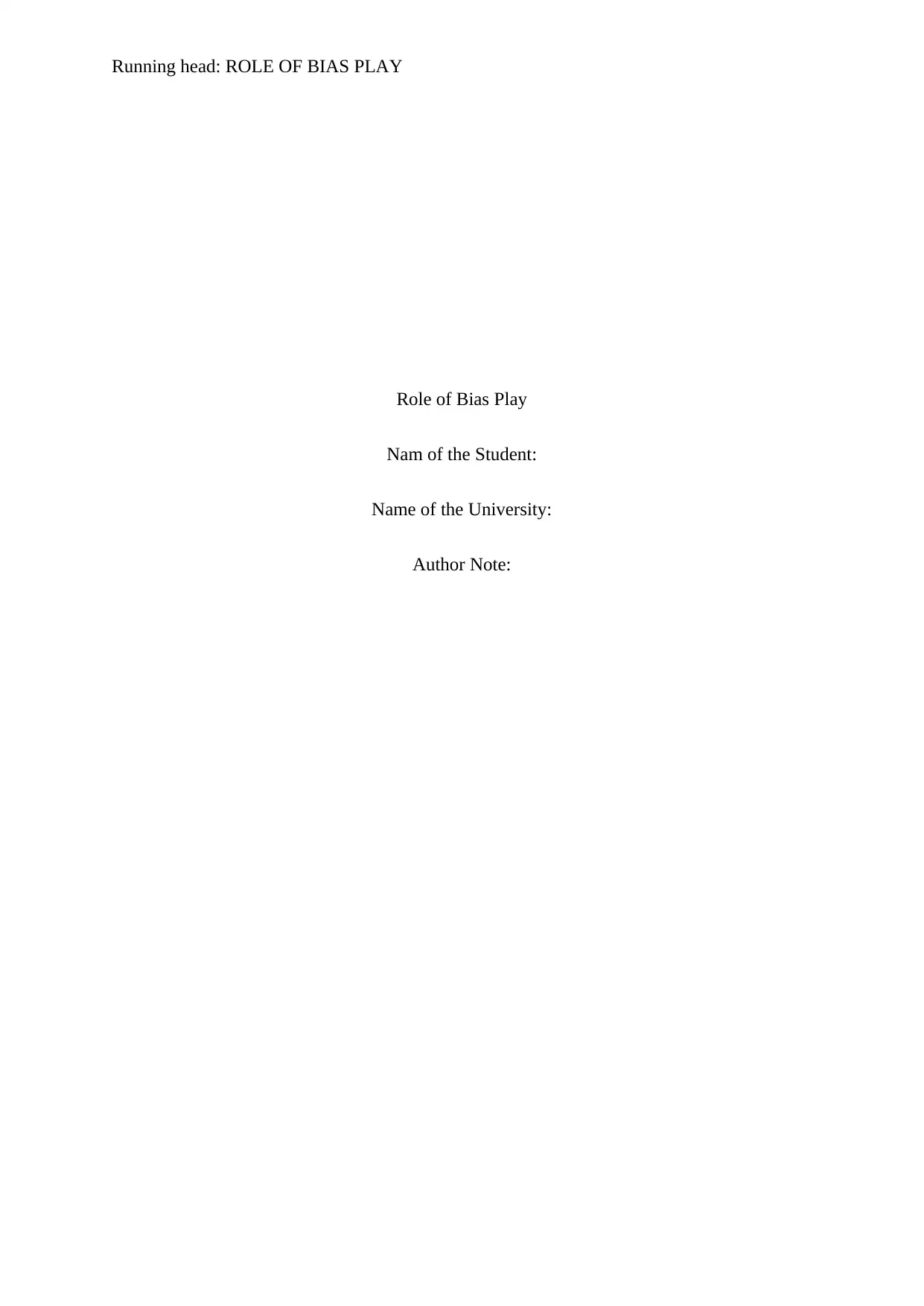
Running head: ROLE OF BIAS PLAY
Role of Bias Play
Nam of the Student:
Name of the University:
Author Note:
Role of Bias Play
Nam of the Student:
Name of the University:
Author Note:
Paraphrase This Document
Need a fresh take? Get an instant paraphrase of this document with our AI Paraphraser
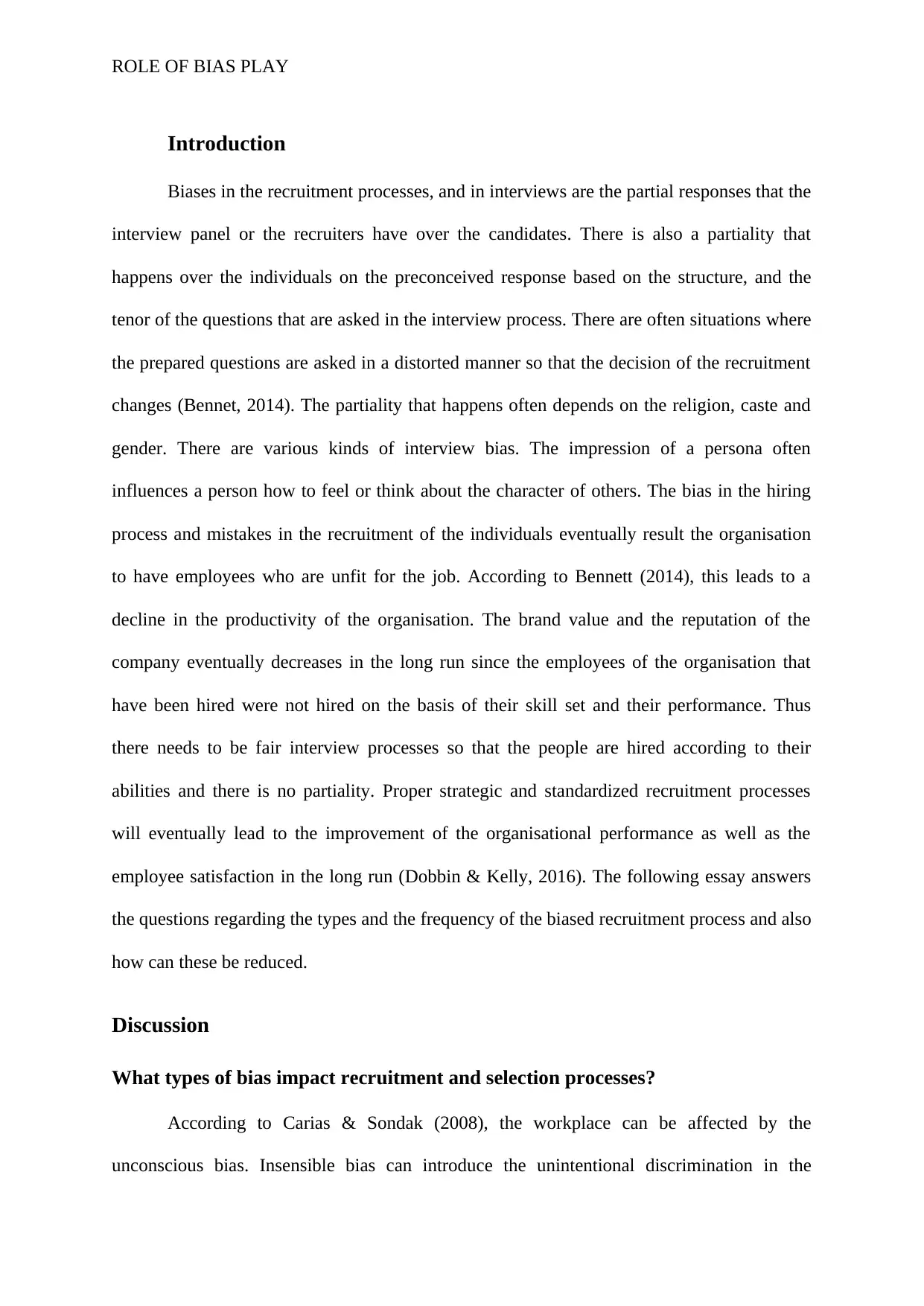
ROLE OF BIAS PLAY
Introduction
Biases in the recruitment processes, and in interviews are the partial responses that the
interview panel or the recruiters have over the candidates. There is also a partiality that
happens over the individuals on the preconceived response based on the structure, and the
tenor of the questions that are asked in the interview process. There are often situations where
the prepared questions are asked in a distorted manner so that the decision of the recruitment
changes (Bennet, 2014). The partiality that happens often depends on the religion, caste and
gender. There are various kinds of interview bias. The impression of a persona often
influences a person how to feel or think about the character of others. The bias in the hiring
process and mistakes in the recruitment of the individuals eventually result the organisation
to have employees who are unfit for the job. According to Bennett (2014), this leads to a
decline in the productivity of the organisation. The brand value and the reputation of the
company eventually decreases in the long run since the employees of the organisation that
have been hired were not hired on the basis of their skill set and their performance. Thus
there needs to be fair interview processes so that the people are hired according to their
abilities and there is no partiality. Proper strategic and standardized recruitment processes
will eventually lead to the improvement of the organisational performance as well as the
employee satisfaction in the long run (Dobbin & Kelly, 2016). The following essay answers
the questions regarding the types and the frequency of the biased recruitment process and also
how can these be reduced.
Discussion
What types of bias impact recruitment and selection processes?
According to Carias & Sondak (2008), the workplace can be affected by the
unconscious bias. Insensible bias can introduce the unintentional discrimination in the
Introduction
Biases in the recruitment processes, and in interviews are the partial responses that the
interview panel or the recruiters have over the candidates. There is also a partiality that
happens over the individuals on the preconceived response based on the structure, and the
tenor of the questions that are asked in the interview process. There are often situations where
the prepared questions are asked in a distorted manner so that the decision of the recruitment
changes (Bennet, 2014). The partiality that happens often depends on the religion, caste and
gender. There are various kinds of interview bias. The impression of a persona often
influences a person how to feel or think about the character of others. The bias in the hiring
process and mistakes in the recruitment of the individuals eventually result the organisation
to have employees who are unfit for the job. According to Bennett (2014), this leads to a
decline in the productivity of the organisation. The brand value and the reputation of the
company eventually decreases in the long run since the employees of the organisation that
have been hired were not hired on the basis of their skill set and their performance. Thus
there needs to be fair interview processes so that the people are hired according to their
abilities and there is no partiality. Proper strategic and standardized recruitment processes
will eventually lead to the improvement of the organisational performance as well as the
employee satisfaction in the long run (Dobbin & Kelly, 2016). The following essay answers
the questions regarding the types and the frequency of the biased recruitment process and also
how can these be reduced.
Discussion
What types of bias impact recruitment and selection processes?
According to Carias & Sondak (2008), the workplace can be affected by the
unconscious bias. Insensible bias can introduce the unintentional discrimination in the
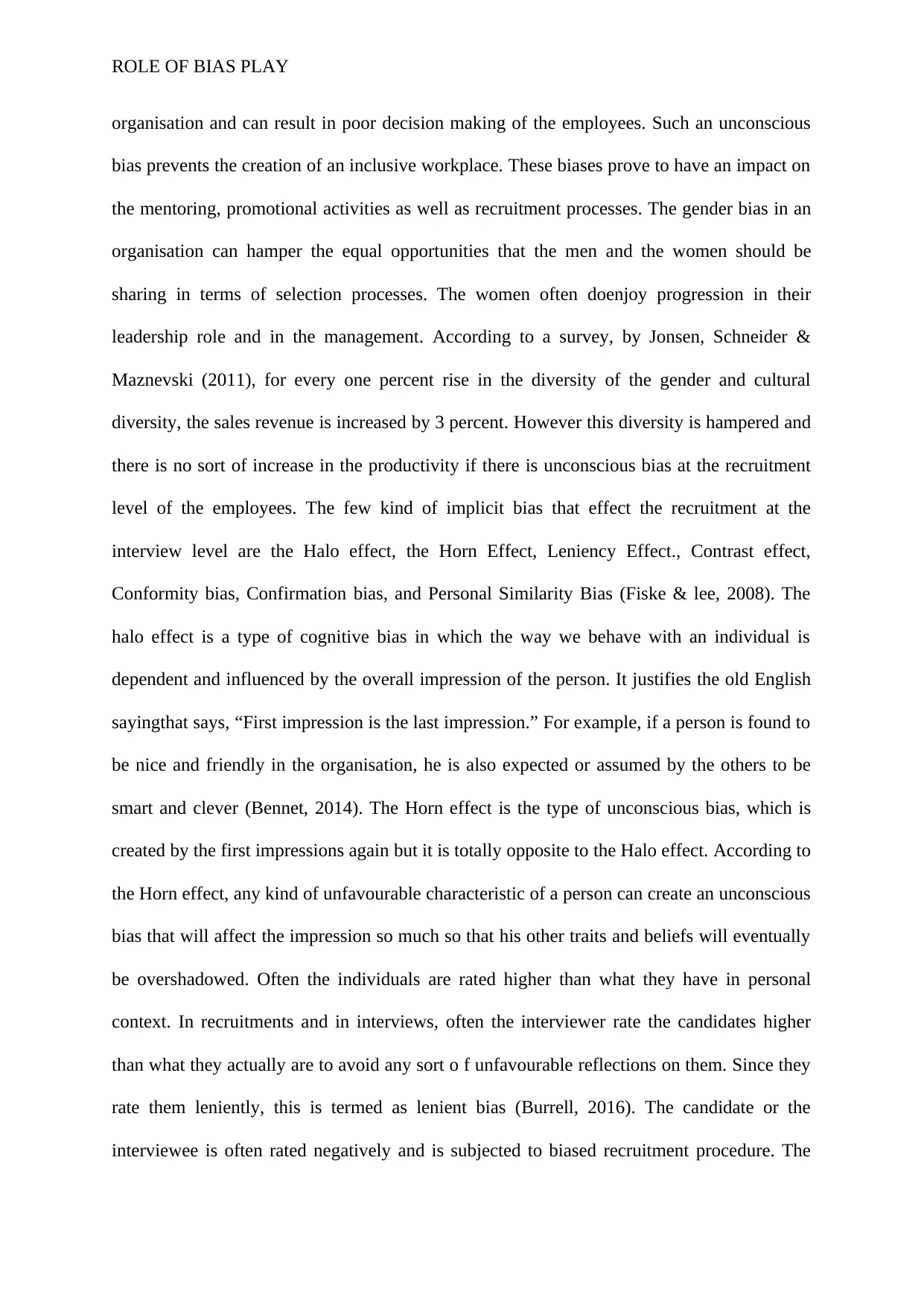
ROLE OF BIAS PLAY
organisation and can result in poor decision making of the employees. Such an unconscious
bias prevents the creation of an inclusive workplace. These biases prove to have an impact on
the mentoring, promotional activities as well as recruitment processes. The gender bias in an
organisation can hamper the equal opportunities that the men and the women should be
sharing in terms of selection processes. The women often doenjoy progression in their
leadership role and in the management. According to a survey, by Jonsen, Schneider &
Maznevski (2011), for every one percent rise in the diversity of the gender and cultural
diversity, the sales revenue is increased by 3 percent. However this diversity is hampered and
there is no sort of increase in the productivity if there is unconscious bias at the recruitment
level of the employees. The few kind of implicit bias that effect the recruitment at the
interview level are the Halo effect, the Horn Effect, Leniency Effect., Contrast effect,
Conformity bias, Confirmation bias, and Personal Similarity Bias (Fiske & lee, 2008). The
halo effect is a type of cognitive bias in which the way we behave with an individual is
dependent and influenced by the overall impression of the person. It justifies the old English
sayingthat says, “First impression is the last impression.” For example, if a person is found to
be nice and friendly in the organisation, he is also expected or assumed by the others to be
smart and clever (Bennet, 2014). The Horn effect is the type of unconscious bias, which is
created by the first impressions again but it is totally opposite to the Halo effect. According to
the Horn effect, any kind of unfavourable characteristic of a person can create an unconscious
bias that will affect the impression so much so that his other traits and beliefs will eventually
be overshadowed. Often the individuals are rated higher than what they have in personal
context. In recruitments and in interviews, often the interviewer rate the candidates higher
than what they actually are to avoid any sort o f unfavourable reflections on them. Since they
rate them leniently, this is termed as lenient bias (Burrell, 2016). The candidate or the
interviewee is often rated negatively and is subjected to biased recruitment procedure. The
organisation and can result in poor decision making of the employees. Such an unconscious
bias prevents the creation of an inclusive workplace. These biases prove to have an impact on
the mentoring, promotional activities as well as recruitment processes. The gender bias in an
organisation can hamper the equal opportunities that the men and the women should be
sharing in terms of selection processes. The women often doenjoy progression in their
leadership role and in the management. According to a survey, by Jonsen, Schneider &
Maznevski (2011), for every one percent rise in the diversity of the gender and cultural
diversity, the sales revenue is increased by 3 percent. However this diversity is hampered and
there is no sort of increase in the productivity if there is unconscious bias at the recruitment
level of the employees. The few kind of implicit bias that effect the recruitment at the
interview level are the Halo effect, the Horn Effect, Leniency Effect., Contrast effect,
Conformity bias, Confirmation bias, and Personal Similarity Bias (Fiske & lee, 2008). The
halo effect is a type of cognitive bias in which the way we behave with an individual is
dependent and influenced by the overall impression of the person. It justifies the old English
sayingthat says, “First impression is the last impression.” For example, if a person is found to
be nice and friendly in the organisation, he is also expected or assumed by the others to be
smart and clever (Bennet, 2014). The Horn effect is the type of unconscious bias, which is
created by the first impressions again but it is totally opposite to the Halo effect. According to
the Horn effect, any kind of unfavourable characteristic of a person can create an unconscious
bias that will affect the impression so much so that his other traits and beliefs will eventually
be overshadowed. Often the individuals are rated higher than what they have in personal
context. In recruitments and in interviews, often the interviewer rate the candidates higher
than what they actually are to avoid any sort o f unfavourable reflections on them. Since they
rate them leniently, this is termed as lenient bias (Burrell, 2016). The candidate or the
interviewee is often rated negatively and is subjected to biased recruitment procedure. The
⊘ This is a preview!⊘
Do you want full access?
Subscribe today to unlock all pages.

Trusted by 1+ million students worldwide
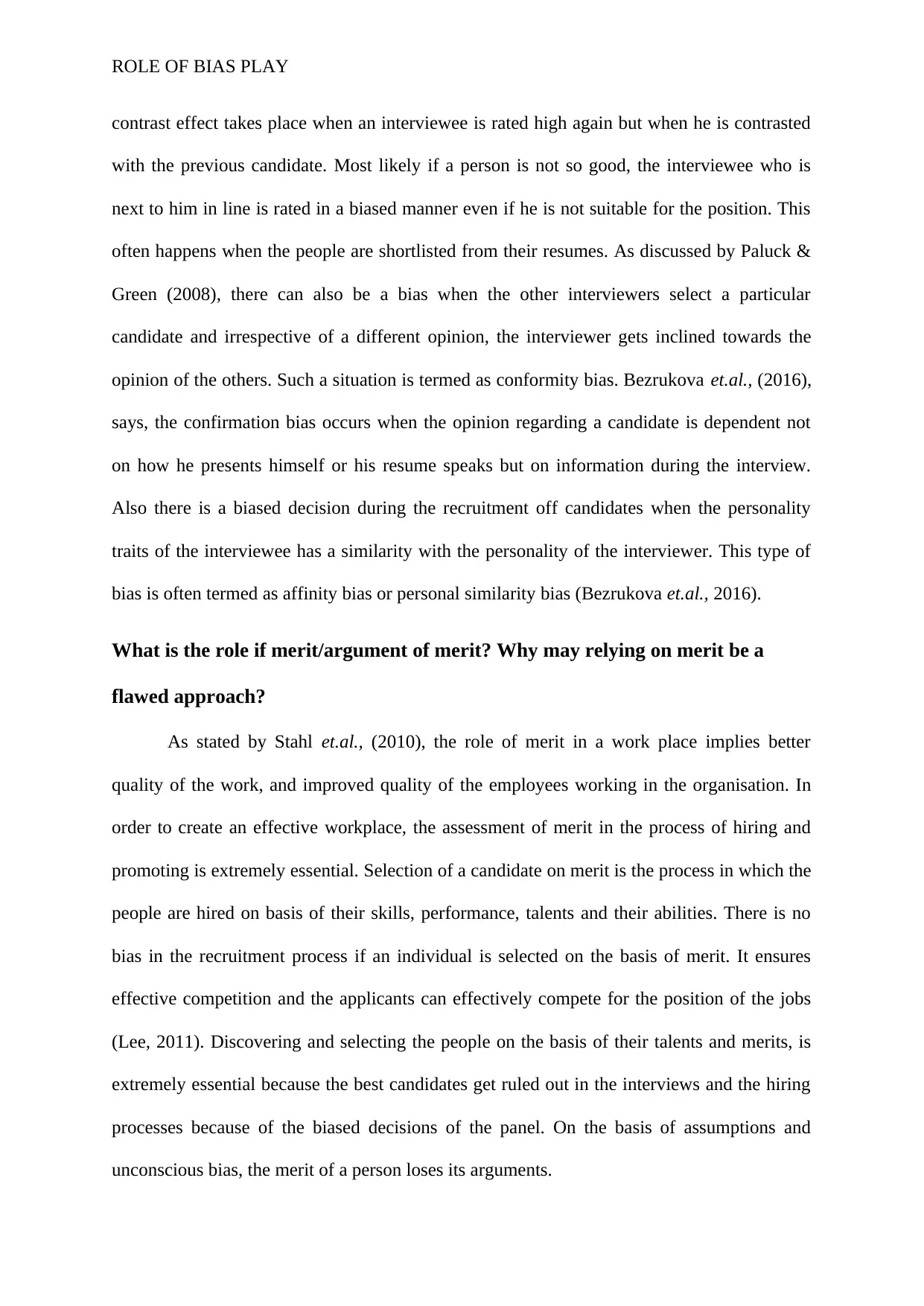
ROLE OF BIAS PLAY
contrast effect takes place when an interviewee is rated high again but when he is contrasted
with the previous candidate. Most likely if a person is not so good, the interviewee who is
next to him in line is rated in a biased manner even if he is not suitable for the position. This
often happens when the people are shortlisted from their resumes. As discussed by Paluck &
Green (2008), there can also be a bias when the other interviewers select a particular
candidate and irrespective of a different opinion, the interviewer gets inclined towards the
opinion of the others. Such a situation is termed as conformity bias. Bezrukova et.al., (2016),
says, the confirmation bias occurs when the opinion regarding a candidate is dependent not
on how he presents himself or his resume speaks but on information during the interview.
Also there is a biased decision during the recruitment off candidates when the personality
traits of the interviewee has a similarity with the personality of the interviewer. This type of
bias is often termed as affinity bias or personal similarity bias (Bezrukova et.al., 2016).
What is the role if merit/argument of merit? Why may relying on merit be a
flawed approach?
As stated by Stahl et.al., (2010), the role of merit in a work place implies better
quality of the work, and improved quality of the employees working in the organisation. In
order to create an effective workplace, the assessment of merit in the process of hiring and
promoting is extremely essential. Selection of a candidate on merit is the process in which the
people are hired on basis of their skills, performance, talents and their abilities. There is no
bias in the recruitment process if an individual is selected on the basis of merit. It ensures
effective competition and the applicants can effectively compete for the position of the jobs
(Lee, 2011). Discovering and selecting the people on the basis of their talents and merits, is
extremely essential because the best candidates get ruled out in the interviews and the hiring
processes because of the biased decisions of the panel. On the basis of assumptions and
unconscious bias, the merit of a person loses its arguments.
contrast effect takes place when an interviewee is rated high again but when he is contrasted
with the previous candidate. Most likely if a person is not so good, the interviewee who is
next to him in line is rated in a biased manner even if he is not suitable for the position. This
often happens when the people are shortlisted from their resumes. As discussed by Paluck &
Green (2008), there can also be a bias when the other interviewers select a particular
candidate and irrespective of a different opinion, the interviewer gets inclined towards the
opinion of the others. Such a situation is termed as conformity bias. Bezrukova et.al., (2016),
says, the confirmation bias occurs when the opinion regarding a candidate is dependent not
on how he presents himself or his resume speaks but on information during the interview.
Also there is a biased decision during the recruitment off candidates when the personality
traits of the interviewee has a similarity with the personality of the interviewer. This type of
bias is often termed as affinity bias or personal similarity bias (Bezrukova et.al., 2016).
What is the role if merit/argument of merit? Why may relying on merit be a
flawed approach?
As stated by Stahl et.al., (2010), the role of merit in a work place implies better
quality of the work, and improved quality of the employees working in the organisation. In
order to create an effective workplace, the assessment of merit in the process of hiring and
promoting is extremely essential. Selection of a candidate on merit is the process in which the
people are hired on basis of their skills, performance, talents and their abilities. There is no
bias in the recruitment process if an individual is selected on the basis of merit. It ensures
effective competition and the applicants can effectively compete for the position of the jobs
(Lee, 2011). Discovering and selecting the people on the basis of their talents and merits, is
extremely essential because the best candidates get ruled out in the interviews and the hiring
processes because of the biased decisions of the panel. On the basis of assumptions and
unconscious bias, the merit of a person loses its arguments.
Paraphrase This Document
Need a fresh take? Get an instant paraphrase of this document with our AI Paraphraser
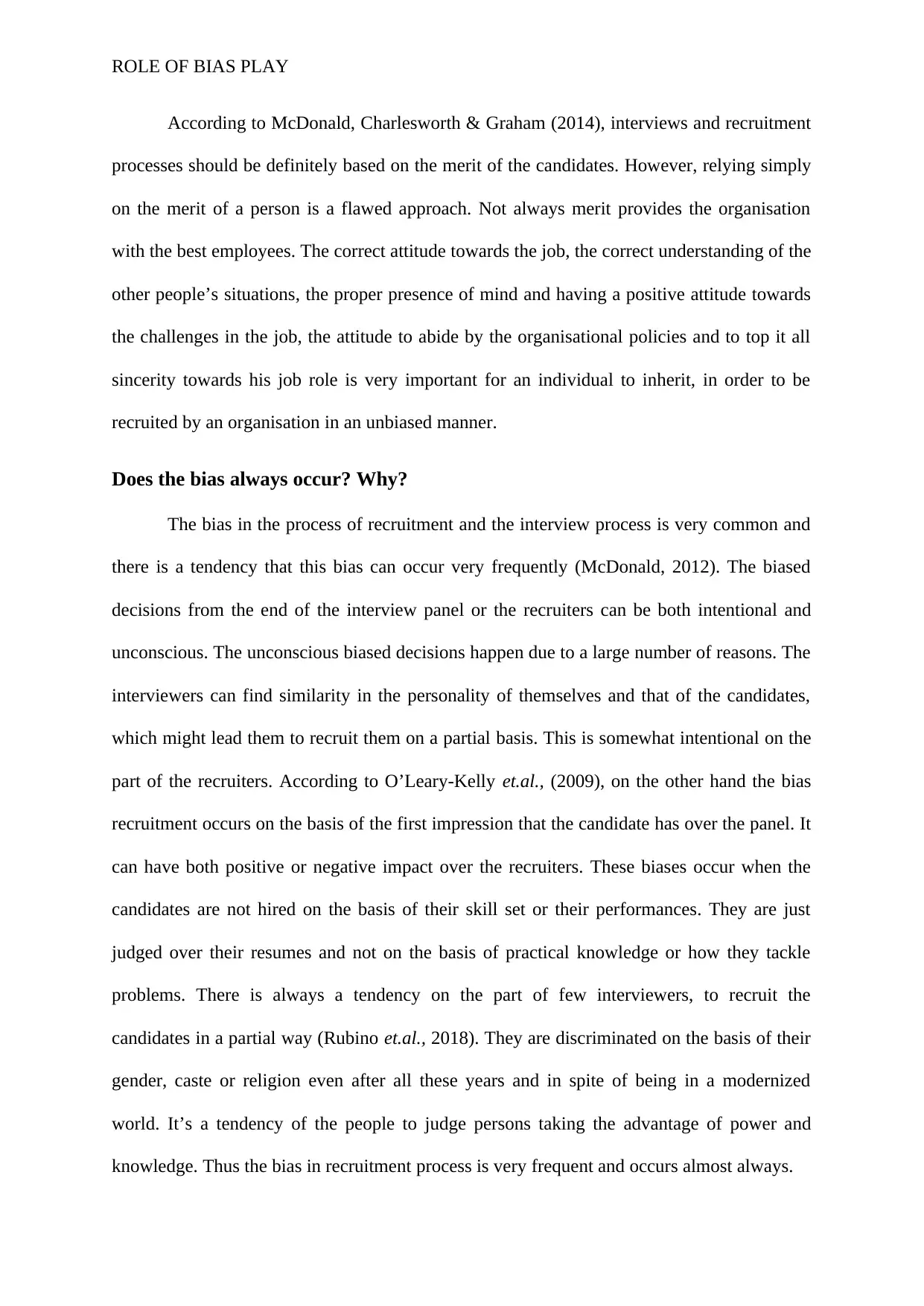
ROLE OF BIAS PLAY
According to McDonald, Charlesworth & Graham (2014), interviews and recruitment
processes should be definitely based on the merit of the candidates. However, relying simply
on the merit of a person is a flawed approach. Not always merit provides the organisation
with the best employees. The correct attitude towards the job, the correct understanding of the
other people’s situations, the proper presence of mind and having a positive attitude towards
the challenges in the job, the attitude to abide by the organisational policies and to top it all
sincerity towards his job role is very important for an individual to inherit, in order to be
recruited by an organisation in an unbiased manner.
Does the bias always occur? Why?
The bias in the process of recruitment and the interview process is very common and
there is a tendency that this bias can occur very frequently (McDonald, 2012). The biased
decisions from the end of the interview panel or the recruiters can be both intentional and
unconscious. The unconscious biased decisions happen due to a large number of reasons. The
interviewers can find similarity in the personality of themselves and that of the candidates,
which might lead them to recruit them on a partial basis. This is somewhat intentional on the
part of the recruiters. According to O’Leary-Kelly et.al., (2009), on the other hand the bias
recruitment occurs on the basis of the first impression that the candidate has over the panel. It
can have both positive or negative impact over the recruiters. These biases occur when the
candidates are not hired on the basis of their skill set or their performances. They are just
judged over their resumes and not on the basis of practical knowledge or how they tackle
problems. There is always a tendency on the part of few interviewers, to recruit the
candidates in a partial way (Rubino et.al., 2018). They are discriminated on the basis of their
gender, caste or religion even after all these years and in spite of being in a modernized
world. It’s a tendency of the people to judge persons taking the advantage of power and
knowledge. Thus the bias in recruitment process is very frequent and occurs almost always.
According to McDonald, Charlesworth & Graham (2014), interviews and recruitment
processes should be definitely based on the merit of the candidates. However, relying simply
on the merit of a person is a flawed approach. Not always merit provides the organisation
with the best employees. The correct attitude towards the job, the correct understanding of the
other people’s situations, the proper presence of mind and having a positive attitude towards
the challenges in the job, the attitude to abide by the organisational policies and to top it all
sincerity towards his job role is very important for an individual to inherit, in order to be
recruited by an organisation in an unbiased manner.
Does the bias always occur? Why?
The bias in the process of recruitment and the interview process is very common and
there is a tendency that this bias can occur very frequently (McDonald, 2012). The biased
decisions from the end of the interview panel or the recruiters can be both intentional and
unconscious. The unconscious biased decisions happen due to a large number of reasons. The
interviewers can find similarity in the personality of themselves and that of the candidates,
which might lead them to recruit them on a partial basis. This is somewhat intentional on the
part of the recruiters. According to O’Leary-Kelly et.al., (2009), on the other hand the bias
recruitment occurs on the basis of the first impression that the candidate has over the panel. It
can have both positive or negative impact over the recruiters. These biases occur when the
candidates are not hired on the basis of their skill set or their performances. They are just
judged over their resumes and not on the basis of practical knowledge or how they tackle
problems. There is always a tendency on the part of few interviewers, to recruit the
candidates in a partial way (Rubino et.al., 2018). They are discriminated on the basis of their
gender, caste or religion even after all these years and in spite of being in a modernized
world. It’s a tendency of the people to judge persons taking the advantage of power and
knowledge. Thus the bias in recruitment process is very frequent and occurs almost always.
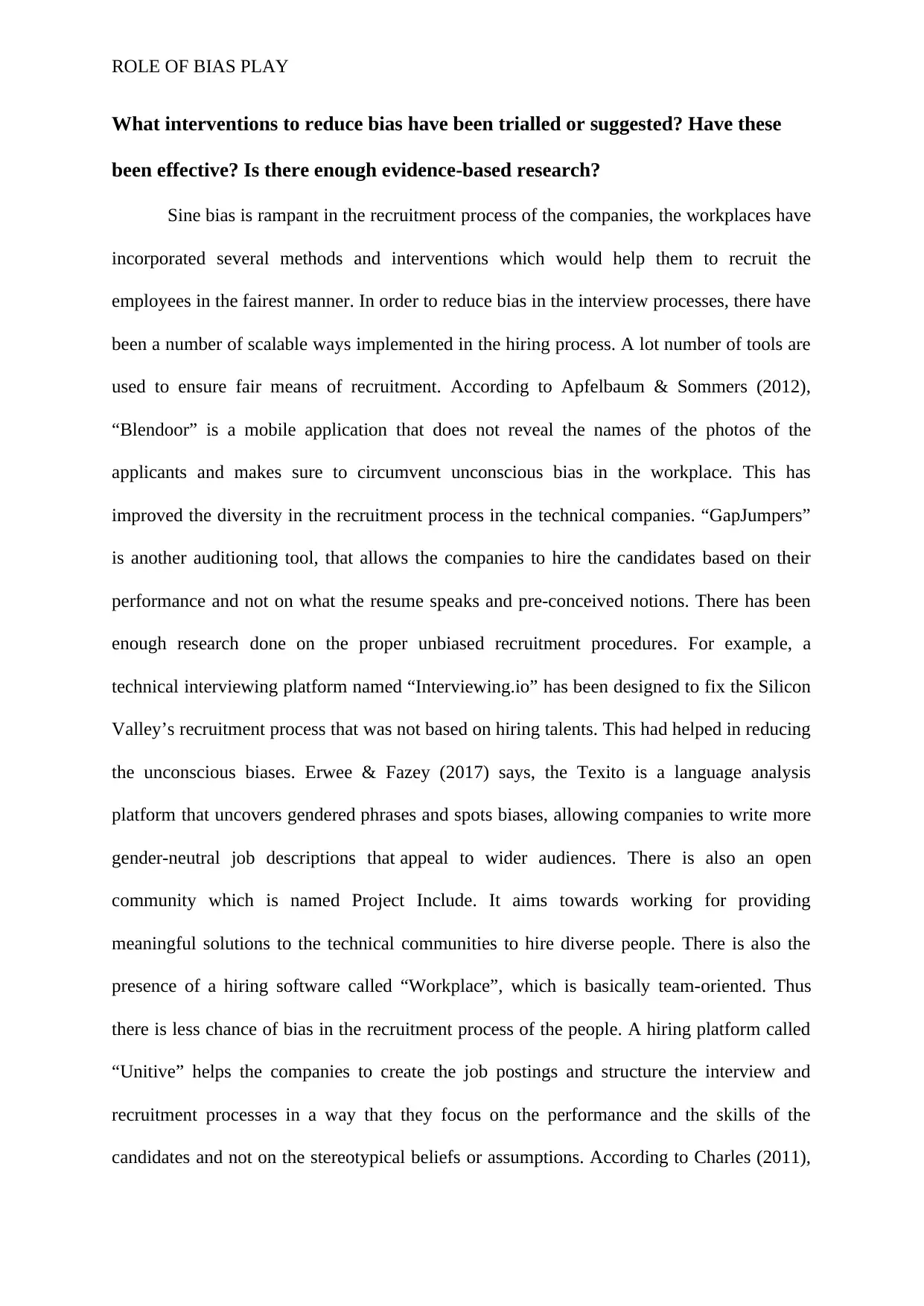
ROLE OF BIAS PLAY
What interventions to reduce bias have been trialled or suggested? Have these
been effective? Is there enough evidence-based research?
Sine bias is rampant in the recruitment process of the companies, the workplaces have
incorporated several methods and interventions which would help them to recruit the
employees in the fairest manner. In order to reduce bias in the interview processes, there have
been a number of scalable ways implemented in the hiring process. A lot number of tools are
used to ensure fair means of recruitment. According to Apfelbaum & Sommers (2012),
“Blendoor” is a mobile application that does not reveal the names of the photos of the
applicants and makes sure to circumvent unconscious bias in the workplace. This has
improved the diversity in the recruitment process in the technical companies. “GapJumpers”
is another auditioning tool, that allows the companies to hire the candidates based on their
performance and not on what the resume speaks and pre-conceived notions. There has been
enough research done on the proper unbiased recruitment procedures. For example, a
technical interviewing platform named “Interviewing.io” has been designed to fix the Silicon
Valley’s recruitment process that was not based on hiring talents. This had helped in reducing
the unconscious biases. Erwee & Fazey (2017) says, the Texito is a language analysis
platform that uncovers gendered phrases and spots biases, allowing companies to write more
gender-neutral job descriptions that appeal to wider audiences. There is also an open
community which is named Project Include. It aims towards working for providing
meaningful solutions to the technical communities to hire diverse people. There is also the
presence of a hiring software called “Workplace”, which is basically team-oriented. Thus
there is less chance of bias in the recruitment process of the people. A hiring platform called
“Unitive” helps the companies to create the job postings and structure the interview and
recruitment processes in a way that they focus on the performance and the skills of the
candidates and not on the stereotypical beliefs or assumptions. According to Charles (2011),
What interventions to reduce bias have been trialled or suggested? Have these
been effective? Is there enough evidence-based research?
Sine bias is rampant in the recruitment process of the companies, the workplaces have
incorporated several methods and interventions which would help them to recruit the
employees in the fairest manner. In order to reduce bias in the interview processes, there have
been a number of scalable ways implemented in the hiring process. A lot number of tools are
used to ensure fair means of recruitment. According to Apfelbaum & Sommers (2012),
“Blendoor” is a mobile application that does not reveal the names of the photos of the
applicants and makes sure to circumvent unconscious bias in the workplace. This has
improved the diversity in the recruitment process in the technical companies. “GapJumpers”
is another auditioning tool, that allows the companies to hire the candidates based on their
performance and not on what the resume speaks and pre-conceived notions. There has been
enough research done on the proper unbiased recruitment procedures. For example, a
technical interviewing platform named “Interviewing.io” has been designed to fix the Silicon
Valley’s recruitment process that was not based on hiring talents. This had helped in reducing
the unconscious biases. Erwee & Fazey (2017) says, the Texito is a language analysis
platform that uncovers gendered phrases and spots biases, allowing companies to write more
gender-neutral job descriptions that appeal to wider audiences. There is also an open
community which is named Project Include. It aims towards working for providing
meaningful solutions to the technical communities to hire diverse people. There is also the
presence of a hiring software called “Workplace”, which is basically team-oriented. Thus
there is less chance of bias in the recruitment process of the people. A hiring platform called
“Unitive” helps the companies to create the job postings and structure the interview and
recruitment processes in a way that they focus on the performance and the skills of the
candidates and not on the stereotypical beliefs or assumptions. According to Charles (2011),
⊘ This is a preview!⊘
Do you want full access?
Subscribe today to unlock all pages.

Trusted by 1+ million students worldwide
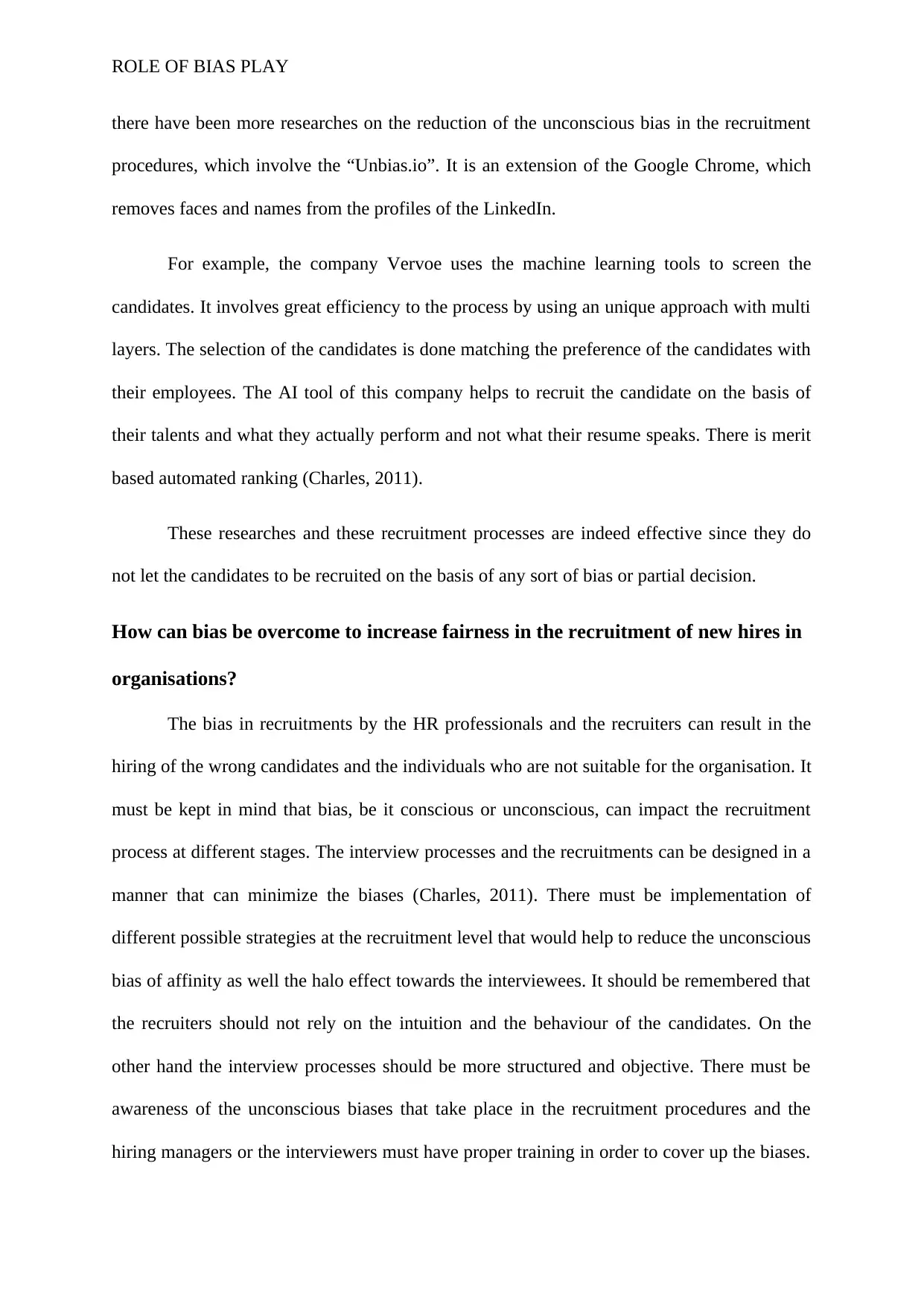
ROLE OF BIAS PLAY
there have been more researches on the reduction of the unconscious bias in the recruitment
procedures, which involve the “Unbias.io”. It is an extension of the Google Chrome, which
removes faces and names from the profiles of the LinkedIn.
For example, the company Vervoe uses the machine learning tools to screen the
candidates. It involves great efficiency to the process by using an unique approach with multi
layers. The selection of the candidates is done matching the preference of the candidates with
their employees. The AI tool of this company helps to recruit the candidate on the basis of
their talents and what they actually perform and not what their resume speaks. There is merit
based automated ranking (Charles, 2011).
These researches and these recruitment processes are indeed effective since they do
not let the candidates to be recruited on the basis of any sort of bias or partial decision.
How can bias be overcome to increase fairness in the recruitment of new hires in
organisations?
The bias in recruitments by the HR professionals and the recruiters can result in the
hiring of the wrong candidates and the individuals who are not suitable for the organisation. It
must be kept in mind that bias, be it conscious or unconscious, can impact the recruitment
process at different stages. The interview processes and the recruitments can be designed in a
manner that can minimize the biases (Charles, 2011). There must be implementation of
different possible strategies at the recruitment level that would help to reduce the unconscious
bias of affinity as well the halo effect towards the interviewees. It should be remembered that
the recruiters should not rely on the intuition and the behaviour of the candidates. On the
other hand the interview processes should be more structured and objective. There must be
awareness of the unconscious biases that take place in the recruitment procedures and the
hiring managers or the interviewers must have proper training in order to cover up the biases.
there have been more researches on the reduction of the unconscious bias in the recruitment
procedures, which involve the “Unbias.io”. It is an extension of the Google Chrome, which
removes faces and names from the profiles of the LinkedIn.
For example, the company Vervoe uses the machine learning tools to screen the
candidates. It involves great efficiency to the process by using an unique approach with multi
layers. The selection of the candidates is done matching the preference of the candidates with
their employees. The AI tool of this company helps to recruit the candidate on the basis of
their talents and what they actually perform and not what their resume speaks. There is merit
based automated ranking (Charles, 2011).
These researches and these recruitment processes are indeed effective since they do
not let the candidates to be recruited on the basis of any sort of bias or partial decision.
How can bias be overcome to increase fairness in the recruitment of new hires in
organisations?
The bias in recruitments by the HR professionals and the recruiters can result in the
hiring of the wrong candidates and the individuals who are not suitable for the organisation. It
must be kept in mind that bias, be it conscious or unconscious, can impact the recruitment
process at different stages. The interview processes and the recruitments can be designed in a
manner that can minimize the biases (Charles, 2011). There must be implementation of
different possible strategies at the recruitment level that would help to reduce the unconscious
bias of affinity as well the halo effect towards the interviewees. It should be remembered that
the recruiters should not rely on the intuition and the behaviour of the candidates. On the
other hand the interview processes should be more structured and objective. There must be
awareness of the unconscious biases that take place in the recruitment procedures and the
hiring managers or the interviewers must have proper training in order to cover up the biases.
Paraphrase This Document
Need a fresh take? Get an instant paraphrase of this document with our AI Paraphraser
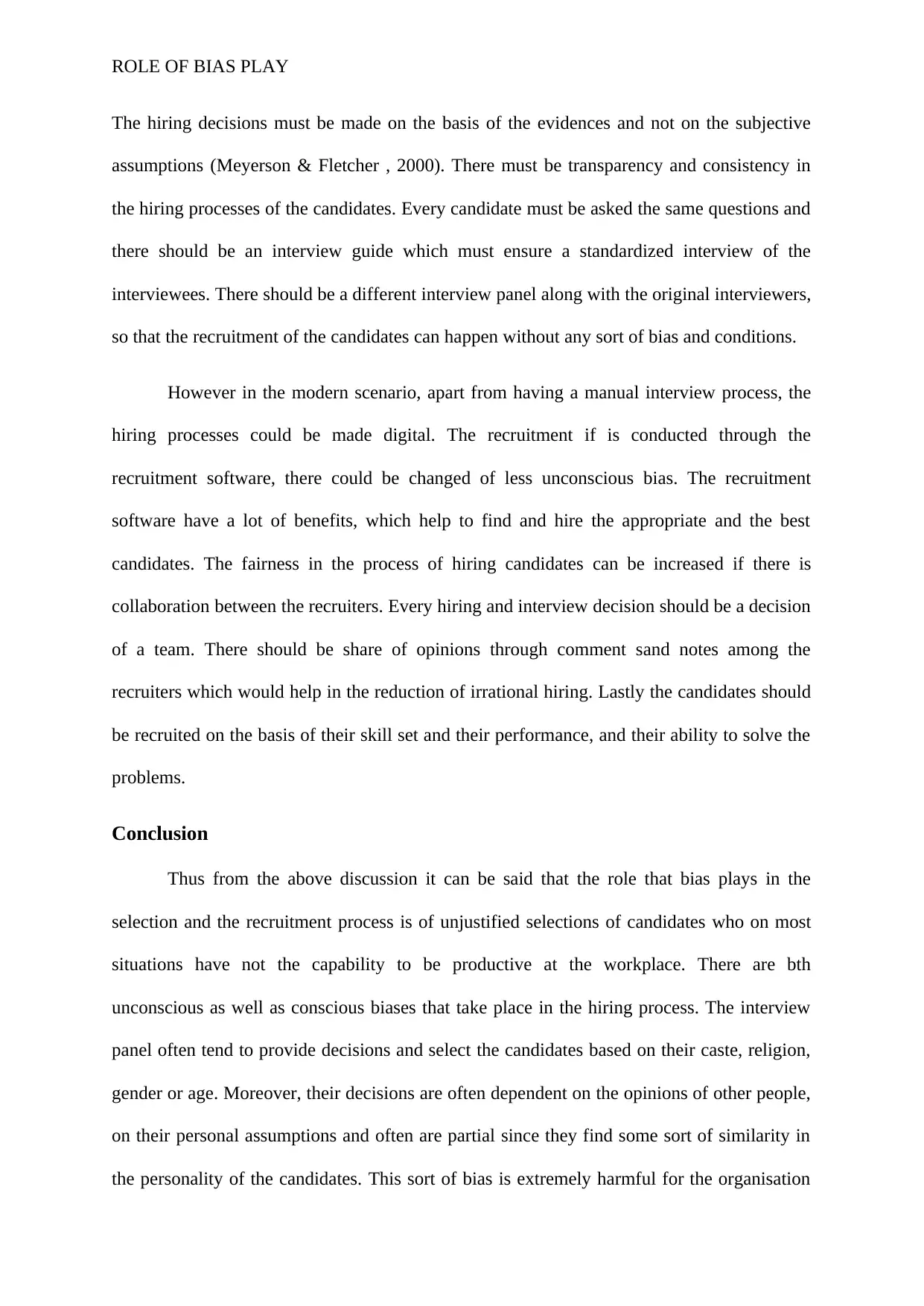
ROLE OF BIAS PLAY
The hiring decisions must be made on the basis of the evidences and not on the subjective
assumptions (Meyerson & Fletcher , 2000). There must be transparency and consistency in
the hiring processes of the candidates. Every candidate must be asked the same questions and
there should be an interview guide which must ensure a standardized interview of the
interviewees. There should be a different interview panel along with the original interviewers,
so that the recruitment of the candidates can happen without any sort of bias and conditions.
However in the modern scenario, apart from having a manual interview process, the
hiring processes could be made digital. The recruitment if is conducted through the
recruitment software, there could be changed of less unconscious bias. The recruitment
software have a lot of benefits, which help to find and hire the appropriate and the best
candidates. The fairness in the process of hiring candidates can be increased if there is
collaboration between the recruiters. Every hiring and interview decision should be a decision
of a team. There should be share of opinions through comment sand notes among the
recruiters which would help in the reduction of irrational hiring. Lastly the candidates should
be recruited on the basis of their skill set and their performance, and their ability to solve the
problems.
Conclusion
Thus from the above discussion it can be said that the role that bias plays in the
selection and the recruitment process is of unjustified selections of candidates who on most
situations have not the capability to be productive at the workplace. There are bth
unconscious as well as conscious biases that take place in the hiring process. The interview
panel often tend to provide decisions and select the candidates based on their caste, religion,
gender or age. Moreover, their decisions are often dependent on the opinions of other people,
on their personal assumptions and often are partial since they find some sort of similarity in
the personality of the candidates. This sort of bias is extremely harmful for the organisation
The hiring decisions must be made on the basis of the evidences and not on the subjective
assumptions (Meyerson & Fletcher , 2000). There must be transparency and consistency in
the hiring processes of the candidates. Every candidate must be asked the same questions and
there should be an interview guide which must ensure a standardized interview of the
interviewees. There should be a different interview panel along with the original interviewers,
so that the recruitment of the candidates can happen without any sort of bias and conditions.
However in the modern scenario, apart from having a manual interview process, the
hiring processes could be made digital. The recruitment if is conducted through the
recruitment software, there could be changed of less unconscious bias. The recruitment
software have a lot of benefits, which help to find and hire the appropriate and the best
candidates. The fairness in the process of hiring candidates can be increased if there is
collaboration between the recruiters. Every hiring and interview decision should be a decision
of a team. There should be share of opinions through comment sand notes among the
recruiters which would help in the reduction of irrational hiring. Lastly the candidates should
be recruited on the basis of their skill set and their performance, and their ability to solve the
problems.
Conclusion
Thus from the above discussion it can be said that the role that bias plays in the
selection and the recruitment process is of unjustified selections of candidates who on most
situations have not the capability to be productive at the workplace. There are bth
unconscious as well as conscious biases that take place in the hiring process. The interview
panel often tend to provide decisions and select the candidates based on their caste, religion,
gender or age. Moreover, their decisions are often dependent on the opinions of other people,
on their personal assumptions and often are partial since they find some sort of similarity in
the personality of the candidates. This sort of bias is extremely harmful for the organisation
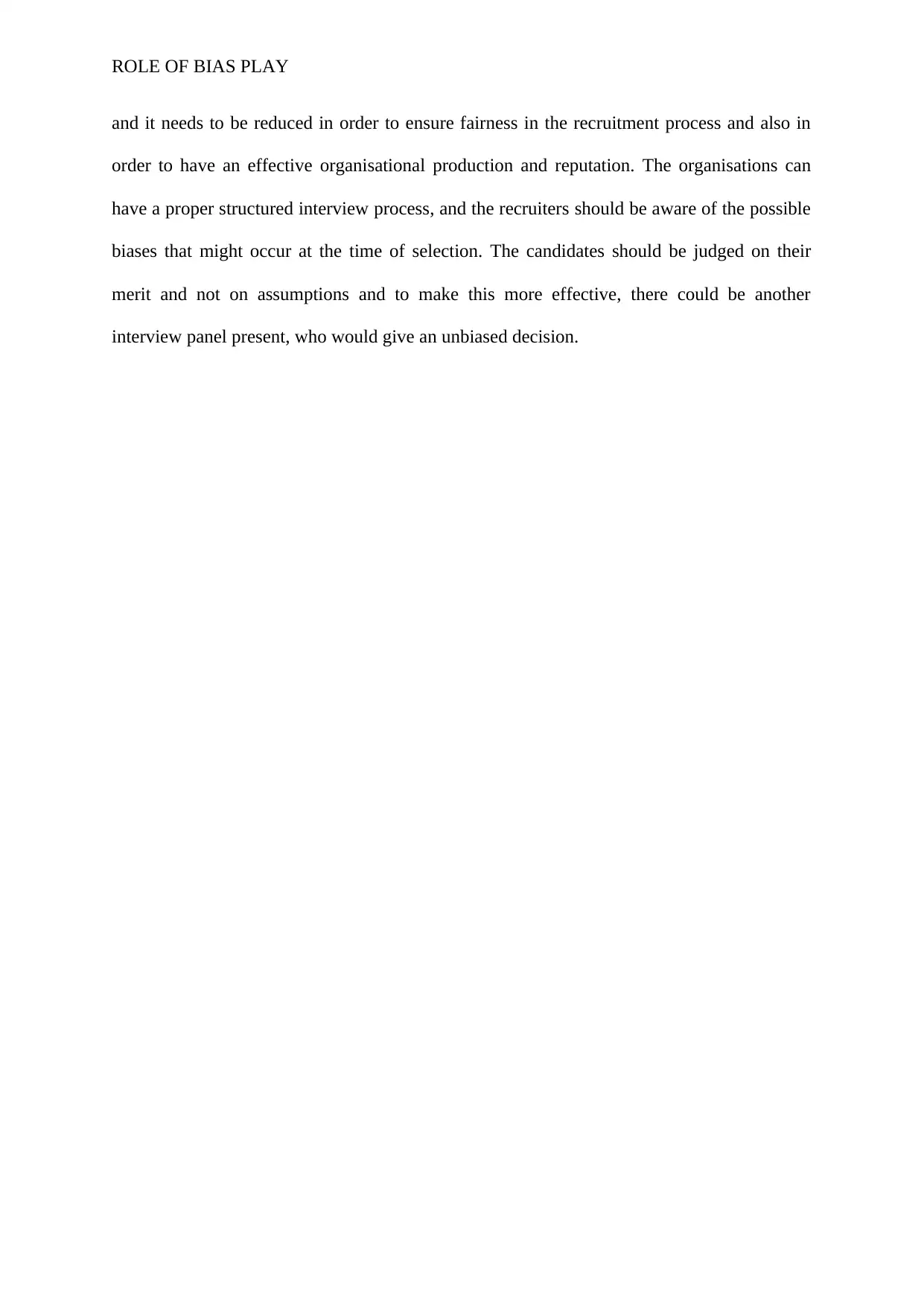
ROLE OF BIAS PLAY
and it needs to be reduced in order to ensure fairness in the recruitment process and also in
order to have an effective organisational production and reputation. The organisations can
have a proper structured interview process, and the recruiters should be aware of the possible
biases that might occur at the time of selection. The candidates should be judged on their
merit and not on assumptions and to make this more effective, there could be another
interview panel present, who would give an unbiased decision.
and it needs to be reduced in order to ensure fairness in the recruitment process and also in
order to have an effective organisational production and reputation. The organisations can
have a proper structured interview process, and the recruiters should be aware of the possible
biases that might occur at the time of selection. The candidates should be judged on their
merit and not on assumptions and to make this more effective, there could be another
interview panel present, who would give an unbiased decision.
⊘ This is a preview!⊘
Do you want full access?
Subscribe today to unlock all pages.

Trusted by 1+ million students worldwide
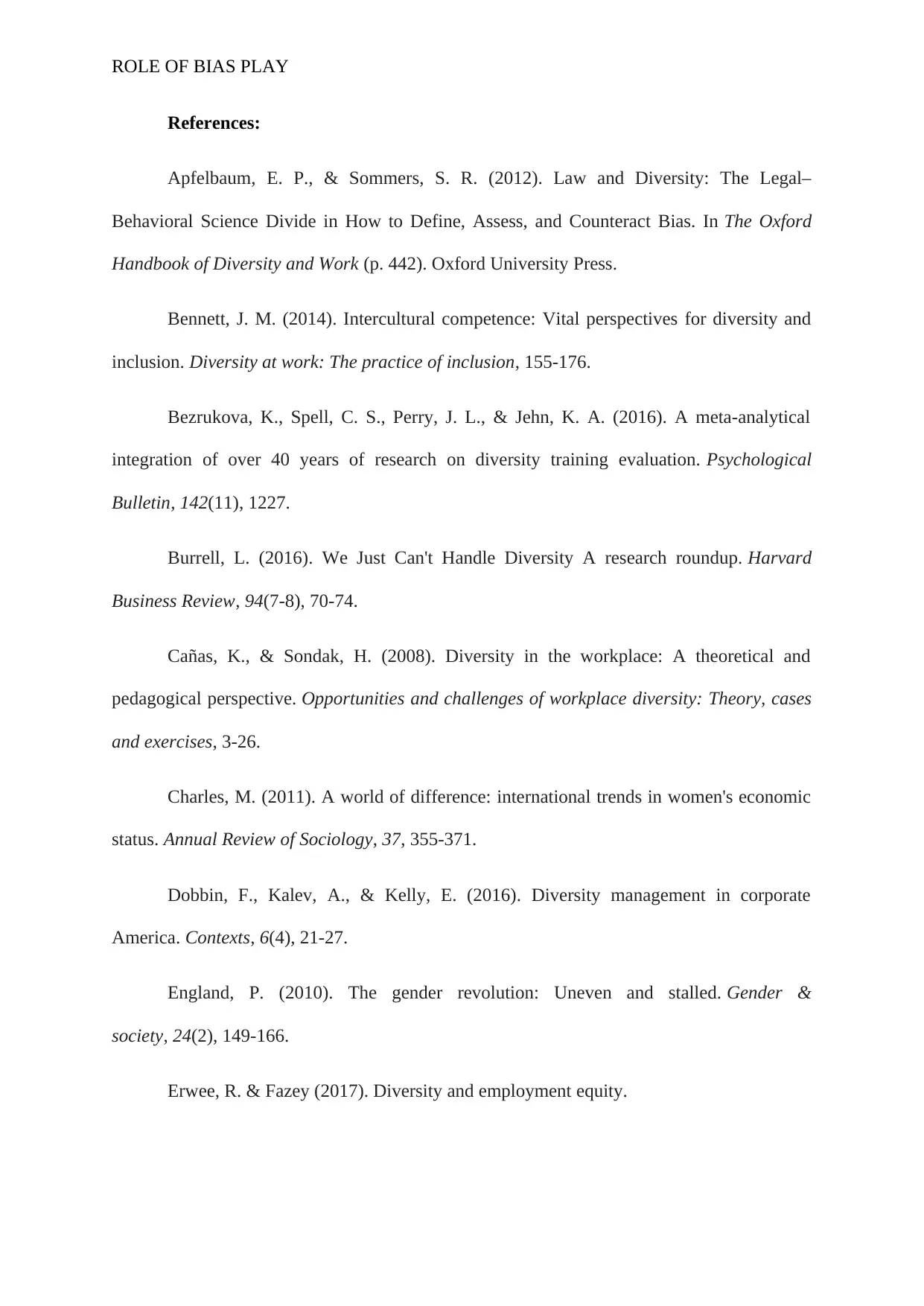
ROLE OF BIAS PLAY
References:
Apfelbaum, E. P., & Sommers, S. R. (2012). Law and Diversity: The Legal–
Behavioral Science Divide in How to Define, Assess, and Counteract Bias. In The Oxford
Handbook of Diversity and Work (p. 442). Oxford University Press.
Bennett, J. M. (2014). Intercultural competence: Vital perspectives for diversity and
inclusion. Diversity at work: The practice of inclusion, 155-176.
Bezrukova, K., Spell, C. S., Perry, J. L., & Jehn, K. A. (2016). A meta-analytical
integration of over 40 years of research on diversity training evaluation. Psychological
Bulletin, 142(11), 1227.
Burrell, L. (2016). We Just Can't Handle Diversity A research roundup. Harvard
Business Review, 94(7-8), 70-74.
Cañas, K., & Sondak, H. (2008). Diversity in the workplace: A theoretical and
pedagogical perspective. Opportunities and challenges of workplace diversity: Theory, cases
and exercises, 3-26.
Charles, M. (2011). A world of difference: international trends in women's economic
status. Annual Review of Sociology, 37, 355-371.
Dobbin, F., Kalev, A., & Kelly, E. (2016). Diversity management in corporate
America. Contexts, 6(4), 21-27.
England, P. (2010). The gender revolution: Uneven and stalled. Gender &
society, 24(2), 149-166.
Erwee, R. & Fazey (2017). Diversity and employment equity.
References:
Apfelbaum, E. P., & Sommers, S. R. (2012). Law and Diversity: The Legal–
Behavioral Science Divide in How to Define, Assess, and Counteract Bias. In The Oxford
Handbook of Diversity and Work (p. 442). Oxford University Press.
Bennett, J. M. (2014). Intercultural competence: Vital perspectives for diversity and
inclusion. Diversity at work: The practice of inclusion, 155-176.
Bezrukova, K., Spell, C. S., Perry, J. L., & Jehn, K. A. (2016). A meta-analytical
integration of over 40 years of research on diversity training evaluation. Psychological
Bulletin, 142(11), 1227.
Burrell, L. (2016). We Just Can't Handle Diversity A research roundup. Harvard
Business Review, 94(7-8), 70-74.
Cañas, K., & Sondak, H. (2008). Diversity in the workplace: A theoretical and
pedagogical perspective. Opportunities and challenges of workplace diversity: Theory, cases
and exercises, 3-26.
Charles, M. (2011). A world of difference: international trends in women's economic
status. Annual Review of Sociology, 37, 355-371.
Dobbin, F., Kalev, A., & Kelly, E. (2016). Diversity management in corporate
America. Contexts, 6(4), 21-27.
England, P. (2010). The gender revolution: Uneven and stalled. Gender &
society, 24(2), 149-166.
Erwee, R. & Fazey (2017). Diversity and employment equity.
Paraphrase This Document
Need a fresh take? Get an instant paraphrase of this document with our AI Paraphraser
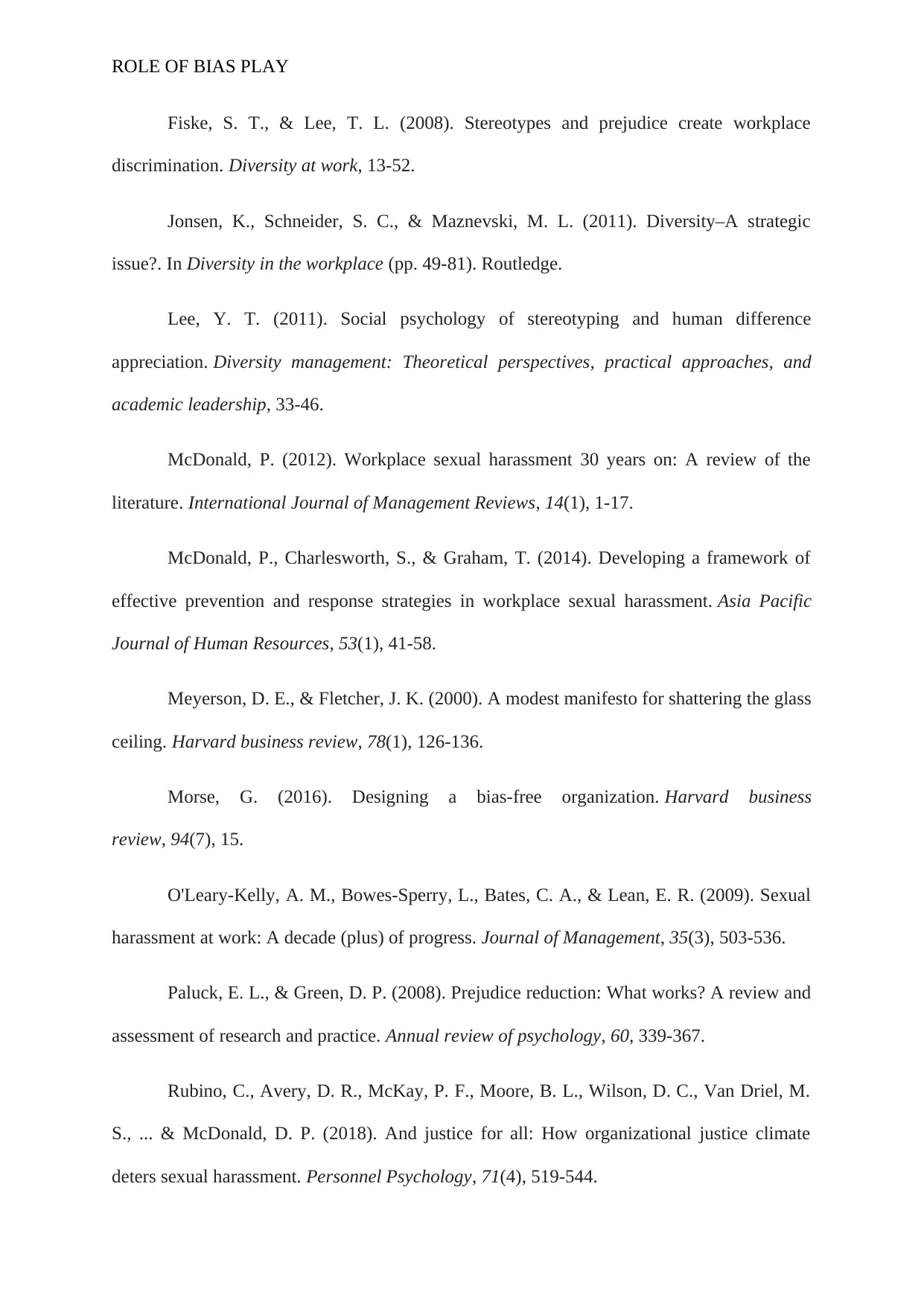
ROLE OF BIAS PLAY
Fiske, S. T., & Lee, T. L. (2008). Stereotypes and prejudice create workplace
discrimination. Diversity at work, 13-52.
Jonsen, K., Schneider, S. C., & Maznevski, M. L. (2011). Diversity–A strategic
issue?. In Diversity in the workplace (pp. 49-81). Routledge.
Lee, Y. T. (2011). Social psychology of stereotyping and human difference
appreciation. Diversity management: Theoretical perspectives, practical approaches, and
academic leadership, 33-46.
McDonald, P. (2012). Workplace sexual harassment 30 years on: A review of the
literature. International Journal of Management Reviews, 14(1), 1-17.
McDonald, P., Charlesworth, S., & Graham, T. (2014). Developing a framework of
effective prevention and response strategies in workplace sexual harassment. Asia Pacific
Journal of Human Resources, 53(1), 41-58.
Meyerson, D. E., & Fletcher, J. K. (2000). A modest manifesto for shattering the glass
ceiling. Harvard business review, 78(1), 126-136.
Morse, G. (2016). Designing a bias-free organization. Harvard business
review, 94(7), 15.
O'Leary-Kelly, A. M., Bowes-Sperry, L., Bates, C. A., & Lean, E. R. (2009). Sexual
harassment at work: A decade (plus) of progress. Journal of Management, 35(3), 503-536.
Paluck, E. L., & Green, D. P. (2008). Prejudice reduction: What works? A review and
assessment of research and practice. Annual review of psychology, 60, 339-367.
Rubino, C., Avery, D. R., McKay, P. F., Moore, B. L., Wilson, D. C., Van Driel, M.
S., ... & McDonald, D. P. (2018). And justice for all: How organizational justice climate
deters sexual harassment. Personnel Psychology, 71(4), 519-544.
Fiske, S. T., & Lee, T. L. (2008). Stereotypes and prejudice create workplace
discrimination. Diversity at work, 13-52.
Jonsen, K., Schneider, S. C., & Maznevski, M. L. (2011). Diversity–A strategic
issue?. In Diversity in the workplace (pp. 49-81). Routledge.
Lee, Y. T. (2011). Social psychology of stereotyping and human difference
appreciation. Diversity management: Theoretical perspectives, practical approaches, and
academic leadership, 33-46.
McDonald, P. (2012). Workplace sexual harassment 30 years on: A review of the
literature. International Journal of Management Reviews, 14(1), 1-17.
McDonald, P., Charlesworth, S., & Graham, T. (2014). Developing a framework of
effective prevention and response strategies in workplace sexual harassment. Asia Pacific
Journal of Human Resources, 53(1), 41-58.
Meyerson, D. E., & Fletcher, J. K. (2000). A modest manifesto for shattering the glass
ceiling. Harvard business review, 78(1), 126-136.
Morse, G. (2016). Designing a bias-free organization. Harvard business
review, 94(7), 15.
O'Leary-Kelly, A. M., Bowes-Sperry, L., Bates, C. A., & Lean, E. R. (2009). Sexual
harassment at work: A decade (plus) of progress. Journal of Management, 35(3), 503-536.
Paluck, E. L., & Green, D. P. (2008). Prejudice reduction: What works? A review and
assessment of research and practice. Annual review of psychology, 60, 339-367.
Rubino, C., Avery, D. R., McKay, P. F., Moore, B. L., Wilson, D. C., Van Driel, M.
S., ... & McDonald, D. P. (2018). And justice for all: How organizational justice climate
deters sexual harassment. Personnel Psychology, 71(4), 519-544.
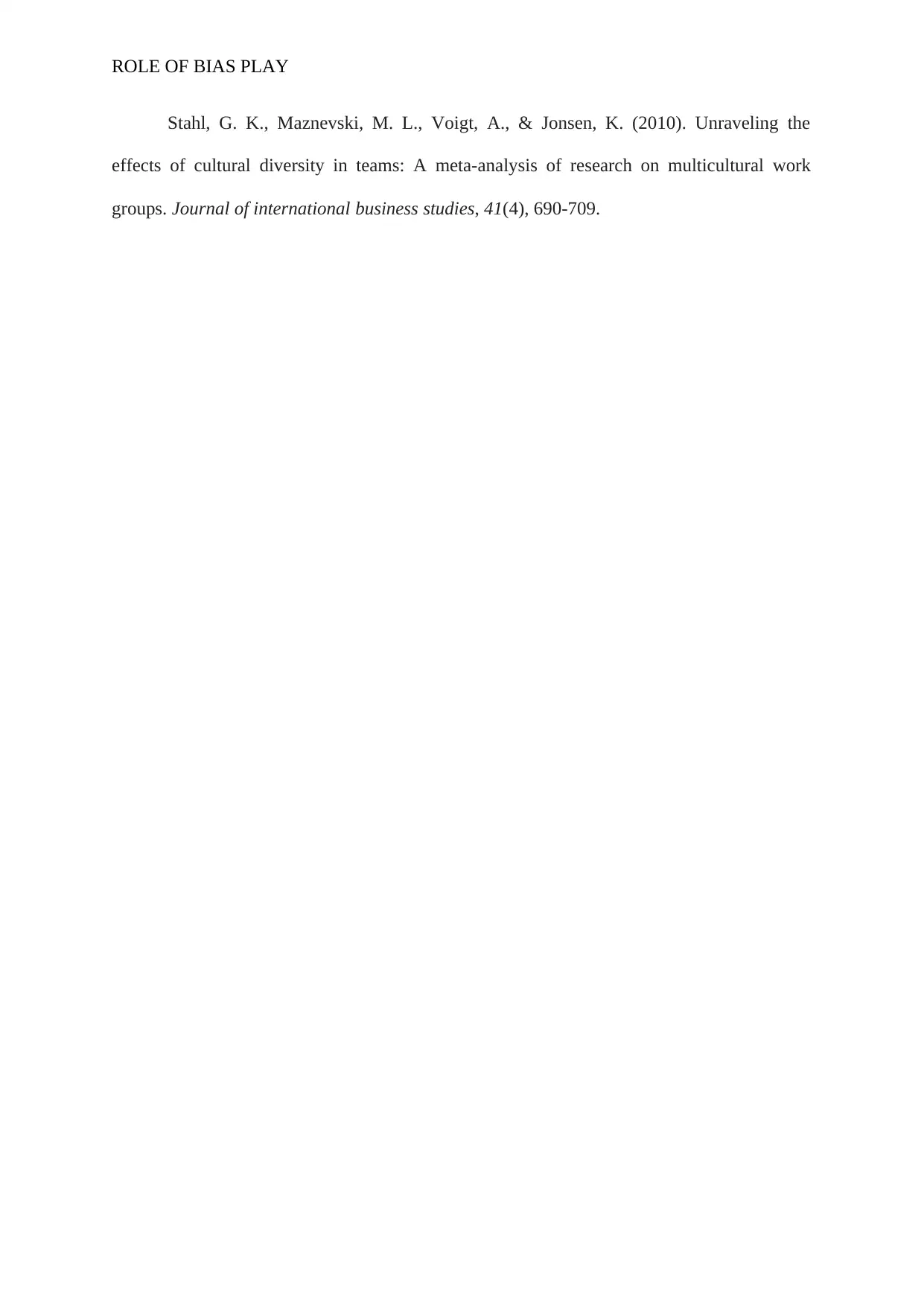
ROLE OF BIAS PLAY
Stahl, G. K., Maznevski, M. L., Voigt, A., & Jonsen, K. (2010). Unraveling the
effects of cultural diversity in teams: A meta-analysis of research on multicultural work
groups. Journal of international business studies, 41(4), 690-709.
Stahl, G. K., Maznevski, M. L., Voigt, A., & Jonsen, K. (2010). Unraveling the
effects of cultural diversity in teams: A meta-analysis of research on multicultural work
groups. Journal of international business studies, 41(4), 690-709.
⊘ This is a preview!⊘
Do you want full access?
Subscribe today to unlock all pages.

Trusted by 1+ million students worldwide
1 out of 12
Related Documents
Your All-in-One AI-Powered Toolkit for Academic Success.
+13062052269
info@desklib.com
Available 24*7 on WhatsApp / Email
![[object Object]](/_next/static/media/star-bottom.7253800d.svg)
Unlock your academic potential
Copyright © 2020–2025 A2Z Services. All Rights Reserved. Developed and managed by ZUCOL.





